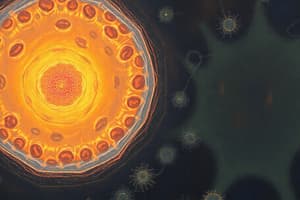Podcast
Questions and Answers
Prokaryotic cells lack a ______ and membrane bound organelles.
Prokaryotic cells lack a ______ and membrane bound organelles.
nucleus
Eukaryotic cells have a ______ structure and can be unicellular or multicellular.
Eukaryotic cells have a ______ structure and can be unicellular or multicellular.
complex
Cells require ______ for survival, which includes amino acids, fatty acids, and water.
Cells require ______ for survival, which includes amino acids, fatty acids, and water.
nutrients
Autotrophs produce their own food using light, water, and ______.
Autotrophs produce their own food using light, water, and ______.
The ______ is the command center of the cell that stores DNA.
The ______ is the command center of the cell that stores DNA.
Mitochondria are known as the powerhouse of the cell, producing ______ through aerobic respiration.
Mitochondria are known as the powerhouse of the cell, producing ______ through aerobic respiration.
Lysosomes break down cellular waste products and recycle them into ______ compounds.
Lysosomes break down cellular waste products and recycle them into ______ compounds.
The ______ provides structure, movement, and stability to the cell.
The ______ provides structure, movement, and stability to the cell.
Flashcards are hidden until you start studying
Study Notes
Cell Types
- Prokaryotic Cells: Lack a nucleus and membrane-bound organelles; simplest structure; typically small and single-celled; reproduce through binary fission.
- Eukaryotic Cells: Have a compartmentalized structure with membrane-bound organelles and a nucleus; larger and more complex; evolved from prokaryotes; can be single-celled or multicellular; reproduce via mitosis.
Requirements for Cell Survival
- Energy Source: Can be light or chemical-based.
- Waste Removal: Essential for maintaining homeostasis.
- Essential Compounds: Cells require amino acids, fatty acids, nucleic acids, ions, water, and other nutrients for various functions.
Functions of a Cell
- Nutrient Uptake: Absorbing necessary substances for survival.
- Reproduction: Ability to create new cells.
- Growth: Increasing in size and complexity.
- Waste Removal: Eliminating harmful byproducts.
- Reactivity: Responding to external environmental changes.
Autotrophs and Heterotrophs
- Autotrophs: Organisms capable of producing their own food using light, water, and carbon dioxide.
- Heterotrophs: Organisms that obtain energy and nutrients by consuming other organisms.
Endosymbiotic Theory
- Proposes that eukaryotic cells originated when a prokaryotic cell ingested a bacterial cell, leading to an endosymbiotic relationship instead of digestion.
Organelles and Their Functions
- Nucleus: Command center of the cell; stores genetic information (DNA).
- Vacuole: Stores water, nutrients, and waste products; helps maintain turgor pressure in plant cells.
- Ribosome: Small structures that synthesize proteins necessary for cellular functions.
- Mitochondria: Known as the powerhouse of the cell; produces ATP through aerobic respiration; involved in detoxification and metabolism of fatty and amino acids.
- Nucleolus: Region within the nucleus responsible for the production and assembly of ribosomes.
- Lysosome: Contains enzymes for breaking down cellular waste and recycling materials within the cell.
- Cytoskeleton: A network of protein fibers that provides shape, stability, and movement capability to the cell.
Studying That Suits You
Use AI to generate personalized quizzes and flashcards to suit your learning preferences.




